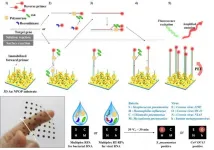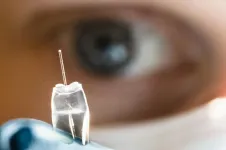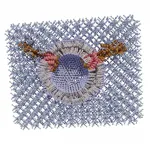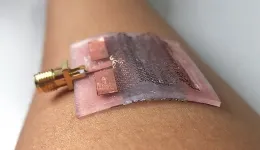Respiratory viral pathogens, quickly caught on-site!
Korea Institute of Materials Science/Samsung Medical Center, Rapid and sensitive multiplex molecular diagnosis of respiratory pathogens using plasmonic isothermal RPA array chip
2021-04-15
(Press-News.org) Researchers in South Korea developed a plasmonic isothermal recombinase polymerase amplification (RPA) array chip, the world's first plasmoinc isothermal PCR technology which can detect 8 types of pathogens (4 bacteria and 4 viruses) that cause acute respiratory infectious diseases in 30 minutes, led by Dr. Sung-Gyu Park and Dr. Ho Sang Jung of the Korea Institute of Materials Science (KIMS, President Jung-Hwan Lee) and by Dr. Min-Young Lee and Dr. Ayoung Woo of Samsung Medical Center. KIMS is a government-funded research institute under the Ministry of Science and ICT.
* PCR(Polymerase Chain Reaction): A test method to amplify and detect nucleic acids target
The current detection technology for COVID-19 is impossible to analyze on-site as it takes about 4 hours or more to be confirmed after specimen collection, making it difficult to isolate the infectee as soon as possible.
To solve this problem, the researchers combined isothermal PCR technology with 3D Au nanostructured substrate which can amplify the fluorescence signal of RPA products with DNA amplicons and sucessfully detected bacterial DNA and viral RNA within 30 minutes.
In addition, the research team also developed a 3D plasmonic array chip for multiplex molecular detections: a chip that can simultaneously analyze 8 pathogens(4 bacteria and 4 viruses).
* 4 bacteria: Streptococcus pneumoniae, Haemophilus influenzae, Chlamydia pneumoniae, Mycoplasma pneumoniae
* 4 viruses: Coronavirus 229E, OC42, NL63(Coronavirus 229E, OC43, NL63), Human metapneumovirus
The "multiplex diagnosis technology for acute respiratory infections" was also confirmed to be valid for clinical specimens collected by nasopharyngeal swabs. The team is planning to perform the reliability test of medical devices through large-scale clinical trials on COVID-19 infectees and applying for approval from the Ministry of Food and Drug Safety.
The "3D plasmonic nanomaterials technology for enhancing optical signal" of KIMS has already been patented in Korea, the US, and China, and the "on-site rapid pathogen detection technology" has been applied for a domestic patent jointly with Samsung Medical Center.
"We developed a medical device that can detect pathogens in half an hour on-site, by developing core plasmonic nanomaterials which enable ultra-sensitive pathogene diagnosis of more than 10 types of respiratory viral pathogens. The on-site molecular diagnostic devices can be prevalent rapidly as we actively research with Samsung Medical Center and domestic diagnostic device companies." said Dr. Sung-Gyu Park, a principal research scientist of KIMS.
Jung-hwan Lee, the president of KIMS said, "KIMS consistently supports to commercialize the on-site molecular diagnosis technology for respiratory infectious disease and ultrasensitive drug detection sensor technology which are based on the 3D highly sensitive plasmonic nanomaterials. We will do our utmost so that our research outcomes contribute to the quality of life and safe society."
INFORMATION:
This research was supported by the Fundamental Research Program of the Korea Institute of Materials Science (KIMS) and funded by Nano Plasmonic In Vitro Diagnostic Research Center of the Ministry of Science and ICT, and the alchemist project of the Ministry of Trade, Industry and Energy.
Also, the technology was published in Biosensors and Bioelectronics (IF:10.257), the principal international journal in the field of analytical chemistry.
* Research paper title: Rapid and sensitive multiplex molecular diagnosis of respiratory pathogens using plasmonic isothermal RPA array chip
The research team was selected as a national R&D excellence in 2020 by developing an ultra-sensitive detection sensor for sepsis through a 3D nano-biosensor chip.
About Korea Institute of Materials Science (KIMS)
KIMS is a non-profit government-funded research institute under the Ministry of Science and ICT (MSIT) of the Republic of Korea. As the only institute specializing in comprehensive materials technologies in Korea, KIMS has contributed to Korean industry by carrying out a wide range of activities related to materials science including R&D, inspection, testing&evaluation, and technology support.
[Attachments] See images for this press release:

ELSE PRESS RELEASES FROM THIS DATE:
2021-04-15
Despite surgery and subsequent treatment with chemotherapy and radiation, the majority of patients experience recurrence of malignant brain tumours. Researchers at Linköping University, Sweden, and the Medical University of Graz, Austria, have shown in cells in culture that an ion pump can deliver drugs more accurately, which gives less severe adverse effects in chemotherapy. The results have been published in Advanced Materials Technologies.
"This is the first time an ion pump has been tested as a possible method to treat malignant brain tumours. ...
2021-04-15
As females age, their bodies typically undergo two significant changes that generally occur during adolescence and middle age. The first, known as menarche, is the time during puberty when a girl begins having monthly menstruation cycles, which often tends to range from 8-13 years of age. She enters the second change, known as menopause, 12 months following her last menstruation cycle when her ovarian function ceases, usually sometime in her 40s or 50s.
The time after menarche and prior to menopause is known as a woman's reproduction life span and marks the years when she is most able to bear children. For many women, these events occur naturally. However, women can enter menopause earlier than ...
2021-04-15
Researchers at King's College London Institute of Psychiatry, Psychology, & Neuroscience, in collaboration with King's College Hospital NHS Foundation Trust, have found small clusters of cells in the brain that identify locations where tumours could become malignant.
The study, which has been published in Neuro-Oncology Advances today, analysed pieces of living human brain tissue from 20 people undergoing brain tumour surgery at King's College Hospital, the largest neuro-oncology centre in Europe. The researchers found groups of tumour cells clustered around blood vessels and believe that these sites could be the seedbeds for malignant progression, the process by which a tumour becomes a fast growing and uncontrolled cancer. ...
2021-04-15
- Study finds for the first time, in Africa, that mutations are associated with delayed clearance of the parasite among children with malaria treated with common Artemisinin-based combination therapies (ACTs).
- While drug efficacy remains high so far, authors call for increased monitoring in the region.
New data provide the first clinical evidence that drug-resistant mutations in the malaria parasite Plasmodium falciparum may be gaining a foothold in Africa. The study, conducted in Rwanda, is published in The Lancet Infectious Diseases journal and finds for the first time that the mutations are associated with delayed parasite clearance, as was first shown in South-East Asia when artemisinin-resistance started to emerge.
The study ...
2021-04-15
Psilocybin, the active compound in magic mushrooms, may be at least as effective as a leading antidepressant medication in a therapeutic setting.
This is the finding of a study carried out by researchers at the Centre for Psychedelic Research at Imperial College London.
In the most rigorous trial to date assessing the therapeutic potential of a 'psychedelic' compound, researchers compared two sessions of psilocybin therapy with a six-week course of a leading antidepressant (a selective serotonin uptake inhibitor called escitalopram) in 59 people with moderate-to-severe depression.
The results, published today in the New England Journal of Medicine, show that while depression ...
2021-04-15
New research by University of Texas at Dallas scientists could help solve a major challenge in the deployment of certain COVID-19 vaccines worldwide -- the need for the vaccines to be kept at below-freezing temperatures during transport and storage.
In a study published online April 13 in Nature Communications, the researchers demonstrate a new, inexpensive technique that generates crystalline exoskeletons around delicate liposomes and other lipid nanoparticles and stabilizes them at room temperature for an extended period -- up to two months -- in their proof-of-concept experiments.
The Moderna and Pfizer/BioNTech COVID-19 vaccines use lipid nanoparticles -- basically spheres of fat molecules -- to protect and deliver the messenger ...
2021-04-14
Biomedical engineers at Duke University have developed a self-assembling nanomaterial that can help limit damage caused by inflammatory diseases by activating key cells in the immune system. In mouse models of psoriasis, the nanofiber-based drug has been shown to mitigate damaging inflammation as effectively as a gold-standard therapy.
One of the hallmarks of inflammatory diseases, like rheumatoid arthritis, Crohn's disease and psoriasis, is the overproduction of signaling proteins, called cytokines, that cause inflammation. One of the most significant ...
2021-04-14
Current research on flexible electronics is paving the way for wireless sensors that can be worn on the body and collect a variety of medical data. But where do the data go? Without a similar flexible transmitting device, these sensors would require wired connections to transmit health data.
Huanyu "Larry" Cheng, Dorothy Quiggle Career Development Assistant Professor of Engineering Science and Mechanics in the Penn State College of Engineering, and two international teams of researchers are developing devices to explore the possibilities of wearable, flexible antennae. They published two papers in April in Nano-Micro Letters and Materials & Design.
Wearable antenna bends, ...
2021-04-14
Biological energy flows, such as in photosynthesis and respiration, depend on the transfer of electrons from one molecule to another. Despite its importance to sustaining life, factors governing the rate of electron transfer, especially over long distances, are not well understood because the systems that mediate such ultrafast processes are very complex. A better understanding of electron transfer rates would help scientists improve chemical transformations, energy conversion, electronic devices, and photonic technologies.
Now, an international team of researchers led by UC Riverside has observed picosecond charge transfer mediated by hydrogen bonds in peptides. A picosecond is one trillionth of a second. ...
2021-04-14
The coronavirus pandemic has led researchers to switch gears or temporarily abandon projects due to health protocols or not being able to travel. But for Patrick Keys and Elizabeth Barnes, husband and wife scientists at Colorado State University, this past year led to a productive research collaboration.
They teamed up with Neil Carter, assistant professor at the University of Michigan, on a paper published in END ...
LAST 30 PRESS RELEASES:
[Press-News.org] Respiratory viral pathogens, quickly caught on-site!
Korea Institute of Materials Science/Samsung Medical Center, Rapid and sensitive multiplex molecular diagnosis of respiratory pathogens using plasmonic isothermal RPA array chip







